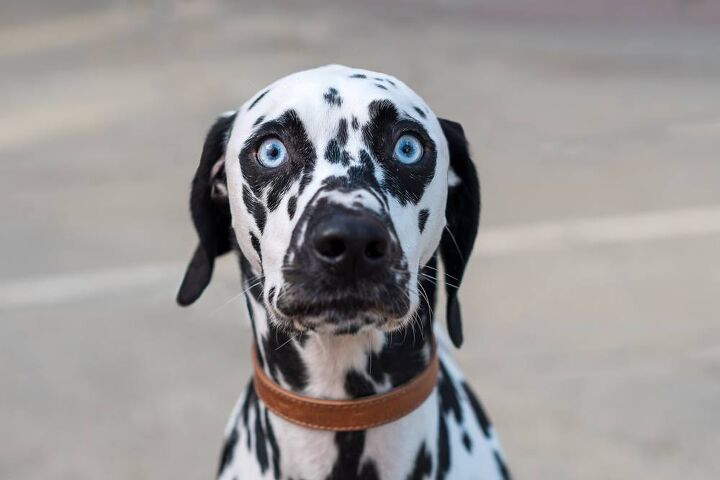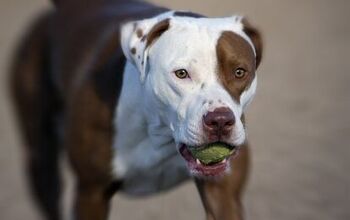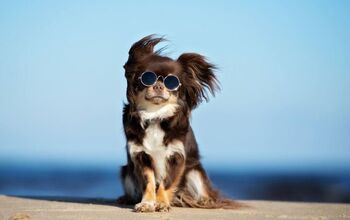Top 10 Dog Breeds With Blue Eyes

If you’ve always been fascinated by the haunting stare of a steely-eyed dog, and wondered where he got those baby blues from, its all about genetics.
In some instances, the dog will possess what is called the Merle gene. In this instance, he will have either two blue eyes or a combination of one blue / one brown due to the dilution of pigment that impacts various sections of his body, including the iris. Which means that yes, he’s also going to have a rather interesting overall appearance because this dilution of pigment also presents as a mottled coat with random spotted markings. This type of pattern can appear on any color of coat, and can also impact his skin pigment. Now, when two dogs that carry the Merle gene are bred, the offspring can be prone to some pretty serious health issues including severe vision and hearing loss. Its for that reason that only mating a Merle-impacted dog with a non-Merle is recommended by breeders and veterinarians.
We then look at the Siberian Husky, which is one of the few breeds known to possess pale- to dark-blue eyes while not carrying the Merle gene. With this big boy, its still down to a gene mutation that causes loss of pigmentation, but in this instance, it only impacts his eyes – not his coat.
Biology lesson over, let’s take a look at some of the top 10 breeds that are renowned for their great big baby blues.
Named the State Dog of Louisiana, this pooch shows the classic Merle gene mottling, with eyes that can range from light to dark blue and even “cracked” with multiple colors appearing within the iris. He’s a hard-working dog that was bred to track and drive cattle or hogs through swamps and forests. So, he’s used to having a job to do and anyone considering adopting him, needs to be prepared for this. He’s super active, highly affectionate with his human pack, and rather protective when it comes to strangers. Now, he’s not a big fan of other dogs, so keeping him on lead during outings is recommended, but for those who love to hike or run, he’s a dream companion. Health issues can present from the Merle connection and include hearing and vision impairment. (Photo credit: Zuzule/Shutterstock)
No surprise that this beautiful hound with the haunting blue-grey eyes is also known as the silver ghost or the gray ghost due to his predictable coloring. Developed in Germany back around 1800, he was the product of crossing a Bloodhound with other native hunting dogs, and the end result in an exceptional pointer. While his being “purpose-built” to hunt, might make you think he’s a rough-and-tumble outdoorsy dog, he’s actually a very sensitive house hound that can suffer from separation anxiety if left alone for too long. But while he’s loyal and gentle to his human pack, small animals may find his instinct to chase, a bit overwhelming. Again, blue eyes can flag genetic issues, so if you’re thinking of welcoming this pup into the family, an ophthalmology evaluation should be done beforehand. (Photo credit: Julie Forward/Shutterstock)
This hard-working pooch with the iconic blue eyes and thick, double-coat is born to run with his pack, so no surprise that he’s completely devoted and loving toward his human pack – your family – and also gets along well with other dogs. But regardless of how much he enjoys your company, never forget that he’s a runner and you should keep him on leash or in a fenced yard unless you’re up for a chase. He’s also very friendly, so you can forget about him ever becoming a super-alert watch dog. While this breed doesn’t possess the Merle gene that can cause hearing or vision loss, he can get juvenile cataracts and it’s recommended he undergo an ophthalmology evaluation beginning at 12 months, with annual check-ups to ensure all remains well. Particularly if you plan to breed him/her. (Photo credit: Sbolotova/Shutterstock)
Both the American and English Cocker Spaniel can display the Merle markings and subsequently produce those big, beautiful blue eyes that make this winsome looking hunting dog, so charming. In fact, this pooch – who dates back to the 1300s where he was developed to help with the bird hunt – is actually quite sensitive and can be downright timid if he isn’t properly socialized as a pup. And while the American Kennel Club doesn’t recognize this variation in coloring as being an acceptable breed standard, it’s still appealing to pet owners and makes Cockers with this type of coat, quite popular. But like all other breeds with Merle markings, a visit to the ophthalmologist to monitor his vision is a wise decision for those who are considering adding him to their family. (Photo credit: ARTSILENSE/Shutterstock)
He’s super smart, excels in agility sports, and with those big blue eyes, this herding pooch is a striking looking dog. Now, superstition had it that those with two differently colored eyes were better able to keep track of sheep because one eye saw them coming and the other saw them going. Of course, that’s not true (we don’t think…) but it suggests this herder has probably sported pretty blue peepers (or a mix) from the time he first appeared, back in the early 1800s. Intense focus and superior herding skills are second nature for this stealthy pooch and while he’s great with kids and other dogs, the family cat may not be such a fan. Whether blue- or brown-eyed, he can suffer from collie eye anomaly and with the blue-eyed version of this pooch, deafness. (Photo credit: xkunclova/Shutterstock)
All dressed up in a dramatic black and white coat, the Harlequin Great Dane sports not only a stunning overall appearance, but a matching set of lovely blue eyes that are fairly standard with this variation on the breed. Now, the markings on the Harlequin have a dotted line to the Merle gene. In fact, if you breed two Harlequins, it’s almost certain that one or two of the pups will be Merle which is why most breeders opt to mate two different varieties of Dane. Pups born with the gene won’t have the iconic black and white coloring, but a soft, mottled grey color along with the blue eyes. Regardless, this gentle giant of a dog is a great family pet that loves to lounge with his people. And like other blue-eyed breeds, vision and hearing loss can be an issue. (Photo credit: David Huntley Creative/Shutterstock)
While not all dogs in this breed have blue eyes, those pale-grey, almost haunting peepers are almost as synonymous with the breed as their herding abilities. In fact, it’s quite common for this breed of dog to present with two differently colored eyes including blue plus brown, hazel, or amber. Now, truth be told, they don’t come from Australia, they actually come from Spain, but their exceptional herding abilities caught the attention of the North American rodeo circuits who immediately brought them over. Legend has it that Native Americans dubbed them “ghost eye” – for understandable reason. You’ll often find them with the iconic dappled Merle coat and of course potential health issues that come with this gene. Annual eye exams with a Canine Ophthalmologist are recommended, to keep this pooch in the prime of health. (Photo credit: Melissa Peluso/Shutterstock)
There are few dog breeds as iconic as this black and white spotted pooch. He’s been heralded in a Disney movie, associated with fire-halls, and has gained a reputation as being a loyal, goofy, fun-loving family dog. But those stunning blue eyes and beautiful white coat with black (or liver colored) spots, are due to extreme piebald pigment genes – an auto-recessive gene that causes the blue irises and patches of color. As a result, this breed can be prone to hereditary deafness and the greater the expanses of white, the more likely the affliction. That said, even with these genetic blips, this affectionate pooch with the sensitive nature is registered with the American Kennel Club, who have developed a prescribed standard for color, depth, size and even distribution of his spots. (Photo credit: Sal Augruso/Shutterstock)
This dynamic redhead with the Velcro dog moniker (because he sticks to you like, well, Velcro) features stunning blue eyes while he’s young and over time they turn to a green or light grey color that results in a dramatic contrast with his warm-toned coat. No question that it’s these good looks and his gentle disposition that make this native of Hungary such a fabulous family pet. Bred for hunting, this eager-to-please dog did double-duty, working as not only a pointer, but a retriever as well – so you know he’s full of energy. In spite of his outdoorsy persona, this pooch suffers from separation anxiety and needs to be with his people. And while his blue peepers aren’t forever, he does tend to run into ocular issues that should be checked out with your vet. (Photo credit: janos.bombicz/Shutterstock)
This breed of dog is relatively new and while his blue eyes and thick, double-coat makes him a doppelganger for the Husky, he’s actually just 10 to 20 pounds. Truth is, while he’s descended from the Alaskan Husky, Siberian Husky, and American Eskimo dog, this pooch is less likely to work a sled and more inclined to work the room. Yes, he loves his people and with his engaging, his affectionate personality he’s the perfect companion dog. But, he’s also highly nimble and really fast, which is ideal for agility coursing. Like the Husky, he also possesses the gene mutation that results in blue eyes or possibly one blue and one of another color. And while he’s friendly with family, he is wary of strangers and a high prey drive can make him less than popular with smaller pets. (Photo credit: Momick/Shutterstock)

Sharing space with three seriously judgy Schnoodles and a feline who prefers to be left alone. #LivingMyBestLife
More by Mary Simpson

































